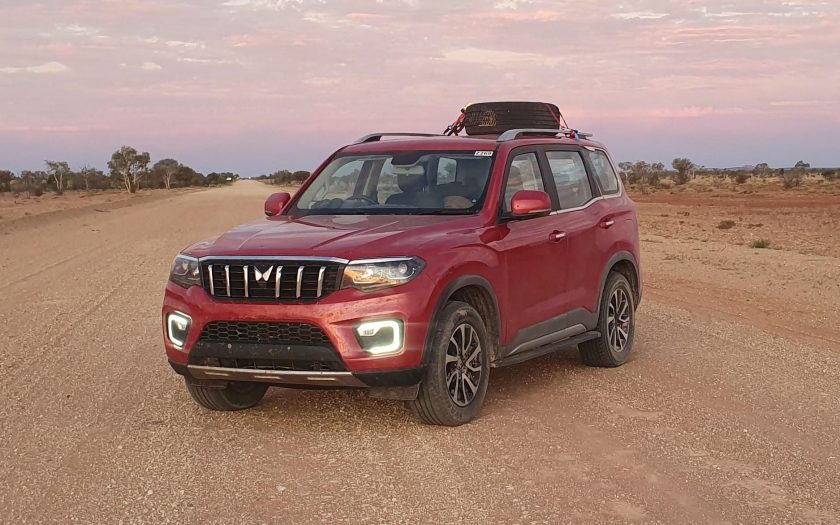WHAT THE CHINESE did to the Australia market looks like it could be replicated by the Indians. Certainly, multi-billion-dollar conglomerate Mahindra has some big plans locally.
The new Mahindra Scorpio is a six-seat, body-on frame, large SUV, and it’s on sale now.
There will be some high-profile brands watching nervously as the Scorpio comes onto the market, promising almost immediate delivery, with the entry level Z8 sharply priced at $41,990 driveaway, and the more comprehensively equipped Z8L at $44,990 driveaway. These are introductory prices until 30 June, 2023. We were unable to clarify what will happen to prices after that date.
To put that into perspective, the major competitors with similar specifications (four-cylinder diesel, four-wheel drive, ladder frame construction) are all significantly dearer. Ford’s Everest is bigger and heavier, but costs from $63,342 to $84,526 (all prices are driveaway in Queensland, and supplied by Mahindra). That puts it at a $21,300 premium over the well-equipped and surprisingly capable Scorpio, and $18,310 more than the top-of-the-range Z8L. A huge jump, and one that’s sure to get many buyers reconsidering their purchase decision.
To our minds, the real competitors for the Scorpio are the Isuzu MU-X, Toyota Fortuner and Mitsubishi Pajero Sport. The Scorpio Z8L undercuts them all ($14,000 less than the Isuzu, $11,000 less than Toyota’s Fortuner and a remarkable $8000 less than the already-sharply priced Pajero Sport). And these savings are all based on the entry level models of each.
All push out a little more than the Scorpio’s 129kW (133kW – Pajero Sport, 150kW – Fortuner, 140kW – MU-X), and it’s a similar story with torque (but there’s not much in it): 400Nm for the Scorpio, 430 for the Pajero Sport, 500Nm for the Fortuner and 450Nm for the MU-X. The Scorpio wins on fuel consumption, at 7.2L/100km (8.0 for the Pajero, 7.6 for the Fortuner, 8.3 for the MU-X).
The Scorpio’s Aisin six-speed auto is more than up to the task. Both the Toyota and Isuzu also get six-speed autos, while the Mitsubishi gets an eight-speeder.
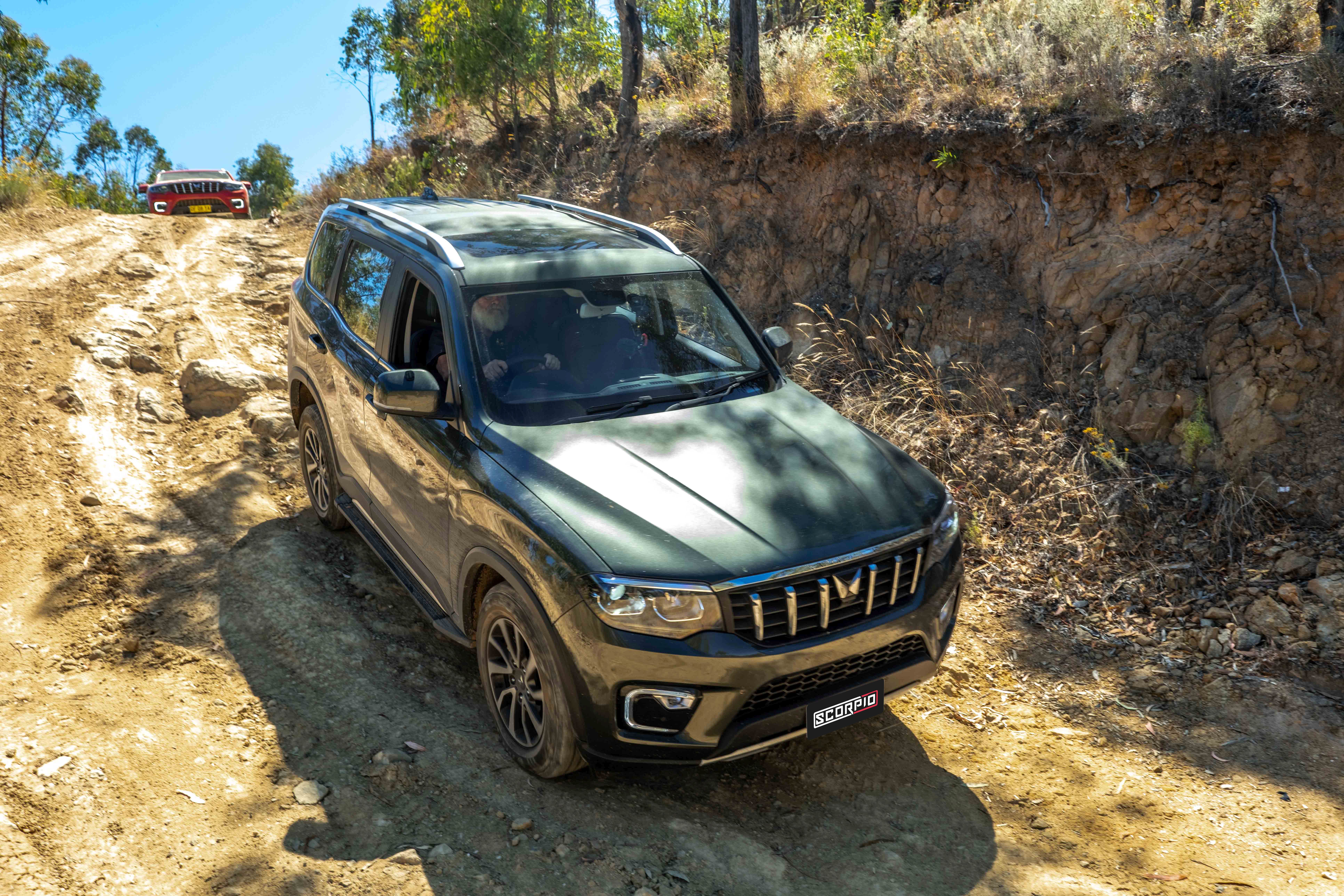
Gross vehicle mass is close, with the Scorpio falling just a little short at 2655kg (Pajero: 2775kg, Fortuner: 2800kg, MU-X: 2800kg). The Scorpio is the tallest of the three (and looks even taller from the rear) and the shortest, but only by a few millimetres. Making up for that, it’s also the widest at 1917mm (Pajero: 1815mm, Fortuner: 1855mm, MU-X: 1870mm). The Everest tops them all at 2207mm. Ground clearance (so important to off-roaders) is a generous 227mm on the Scorpio, compared to 218 for the Pajero, 221 for the Fortuner and 230 for the MU-X, and the Scorpio boasts short front and rear overhangs so approach and departure angles are very impressive (27.2 degree approach, 21.3 departure, 23.5 breakover angle).
Braked towing capacity will be important to buyers. The Scorpio is rated at a comparatively modest 2500kg while the Pajero and Fortuner will tow 3100kg, the MU-X an even more impressive 3500kg. Payload is between 510kg and 525kg (depending on spcifications).
Two other factors buyers should consider are the comparatively small fuel tank (57 litres, meaning range will be between 730km and 840km) and that it requires the addition of AdBlue (the AdBlue tank is 20 litres meaning it won’t need refilling between services).
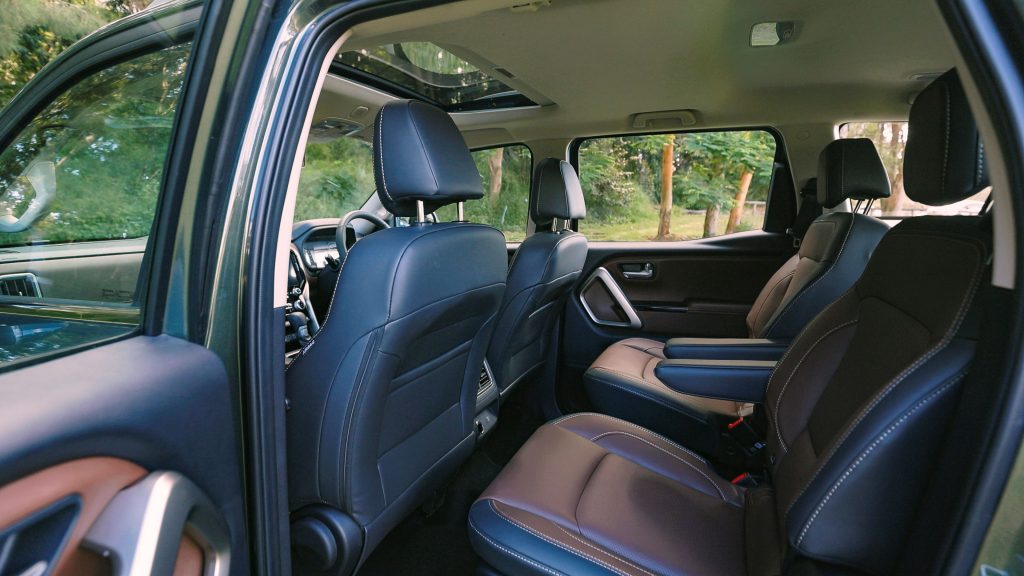
The Scorpio seats six (2/2/2) with Captain’s chairs in the centre row, but we were told that a 2/3/2 option is in the pipeline. The Pajero GLX seats five, the Fortuner and MU-X seven. Interestingly, both the Toyota Prado GX and Ford Everest Ambiente are also limited to five seats.
Okay, so on paper, things look bright for the Scorpio, but a glance at the standard equipment list makes the sales story even stronger.
We don’t usually list all the features, but in this case, we think we should.
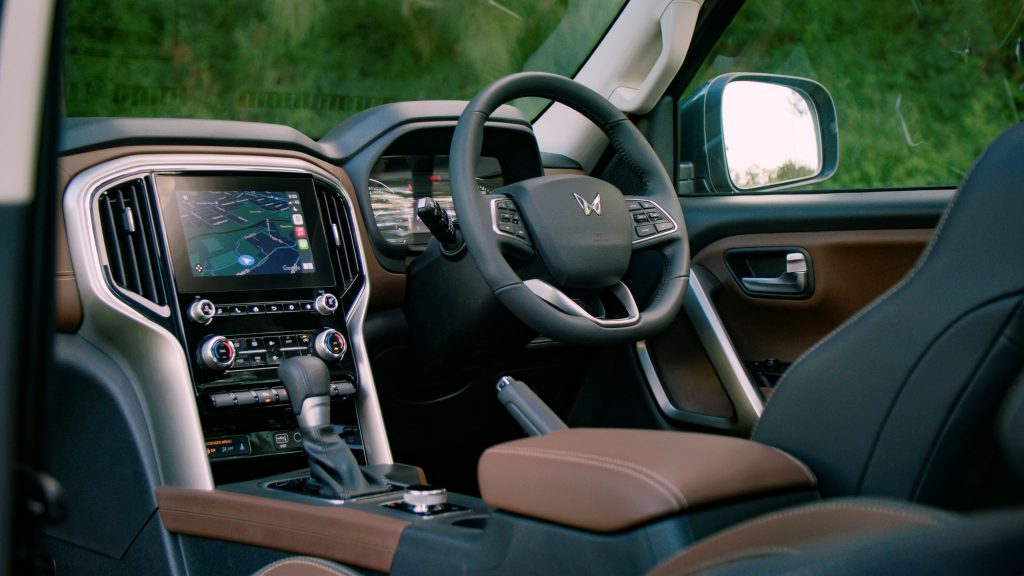
Here’s what the base model Z8 gets:
- Dual pinion electric power steering
- 18-inch alloy wheels
- Brake disc wiping
- Electronic brake prefill
- Vehicle dynamics control
- Traction control system
- Trailer sway mitigation
- Rollover mitigation
- Hill hold control
- Command seating with seat height adjustment and lumbar support
- 2-inch monochrome display
- 8-inch touchscreen infotainment, with Carplay and Android Auto
- Cruise control
- 2nd row air conditioning module
- Cooled glove box
- PM 2.5 filter certification
- Front power windows with anti-pinch
- USB-C port in the second row
- Rear wiper, washer and demister
- Silver skid plates
- Leather wrapped steering wheel and gear lever
- 4XPLOR intelligent 4×4 system with selectable terrain modes (normal, snow, mud & ruts, sand)
- LED headlamps and projector fog lamps with DRL
- LED sequential turn indicators
- Chrome door handles
- Metallic Scorpio-tail element integrated into beltline
- Push button start
- Passive keyless entry
- Power fold external rear vision mirror
- Tyre pressure monitor system
- Auto headlamps
- Auto wipers
- Dual zone air conditioning
- Dual tone dashboard and centre console
- Leatherette interior
The Z8L adds
- 12-speaker Sony audio with twin channel sub-woofer
- Front camera
- Front park assist sensors
- 6-way powered driver’s seat
- 7-inch colour TFT driver’s display
- Wireless charging
You’ll be lucky to match that on most of the top-spec competitors, let alone the entry models.
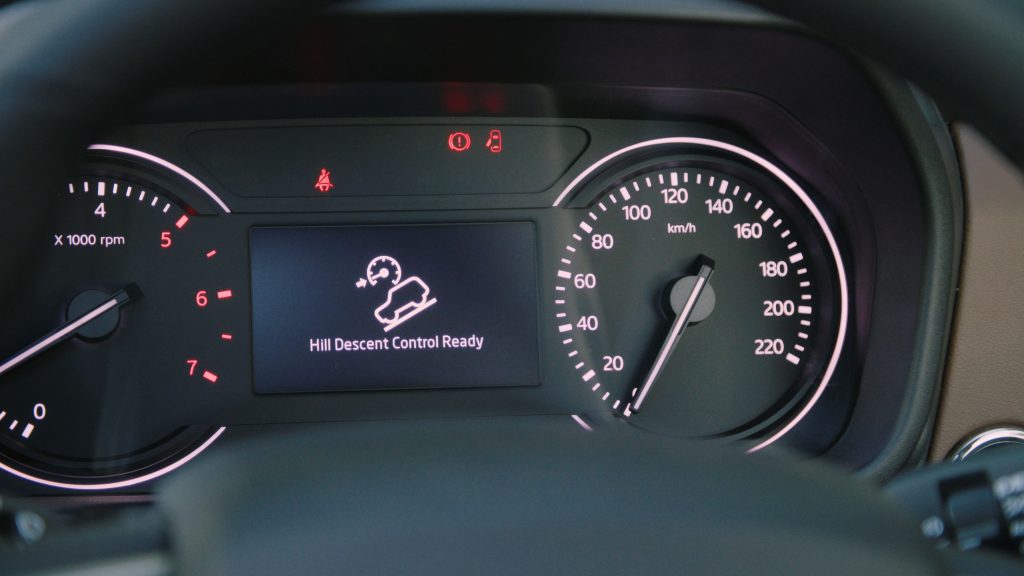
So what don’t you get?
Biggest omission is the lack of autonomous emergency braking. AEB is mandatory on all new vehicles approved for sale from 1 March, 2023, so the Scorpio just snuck in. We’re told AEB will be included with a mid-life update. In any case, AEB will become mandatory on all new vehicles from March 2025.
Other omissions we noted are traffic and speed sign identification. There’s no blind spot monitoring, no lane keep assist, no rear cross traffic alert, no adaptive cruise control, the seat belts are not height adjustable and the steering column is adjustable for height but not reach.
We also were disappointed to see that the rear windows don’t drop all the way into the doors and sit about 80cm proud of the sill when lowered to the limit. We also noted that the side curtain airbags “sort of” extend to the third row. In fact, they extend as far as the middle of the rear side windows.
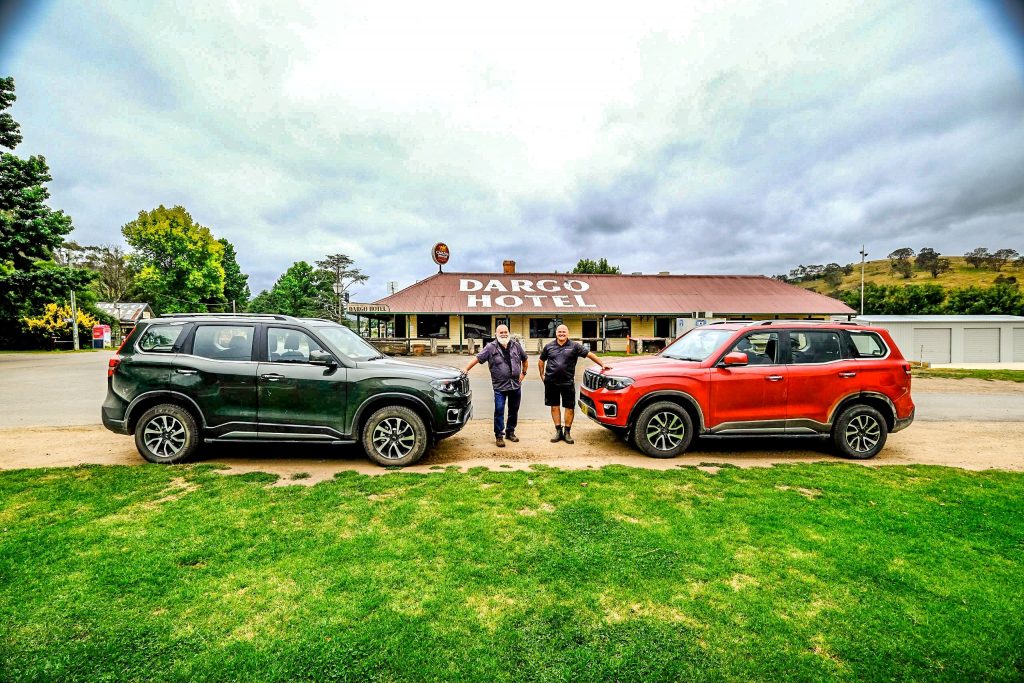
Can you buy with confidence?
Most buyers will never have heard of Mahindra, so a little hesitation would be understandable.
However, Mahindra has been in Australia since 2005 (it started selling tractors and still does to this day). A few years later, the company launched the Pik-Up, an honest but basic workhorse ute and in 2012, the XUV500 mid-size SUV.
Mahindra is a huge conglomerate with a $30 billion annual turnover, 50 percent of it outside India. Last year, Mahindra produced more than 700,000 vehicles.
The Scorpio has undergone a rigorous 120,000km testing program in Australia and a further 50,000km in South Africa.
The Scorpio is covered by a seven-year 150,000km warranty (private buyers) and seven years of roadside assist. Service intervals are 15,000 or every 12 months. A capped price service package hasn’t been announced as yet, but we understand one is being considered.
While not tested by ANCAP, the Scorpio has received a five-star safety rating from the Global New Car Assessment Program (GNCAP) but GNCAP standards are lower than Australia’s ANCAP testing rules. Missing safety features make it unlikely the Scorpio would score a five-star ANCAP rating.
seniordriveraus will bring you a comprehensive launch test review when the embargo is lifted on Wednesday, 26 April
